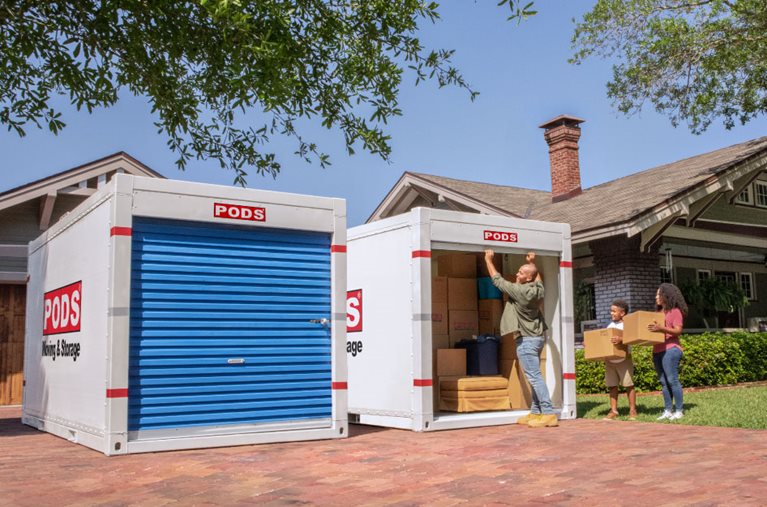
How To Minimize Interstate Moving Costs
Moving Tips and Hacks
Sure, moving somewhere new is exciting. You’re anticipating a fresh start in a completely new environment. But at the same time, there are a lot of stressors that go along with the moving process, including packing up all your belongings and finding the proper way to, well, actually move. Especially if it happens to involve moving to another state and dealing with interstate moving costs. So here’s our guide to help you navigate those cost stressors and get one step closer to that fresh start.
What Is Interstate Moving?
An interstate move refers to the process of moving out of state. Compared to intrastate moving, which takes place within the same state’s lines, interstate moving comes with more regulations and logistics.
Interstate Moving Companies — Costs and Options
Depending on factors such as how many belongings are being moved and the distance traveled, your overall interstate moving costs can vary widely. Naturally, the two main factors when choosing a moving service are cost and convenience. Taking on the responsibility and handling the moving process yourself will save you money, but hiring a moving company will save you time. Prefer a hybrid version of both of these options? Then you may want to consider going the portable container route. Here’s a more detailed look at each of the three main moving options when it comes to interstate moving.
|
Q: What is the average cost of an interstate move in the United States? |
1. Full-Service Movers
Full-service movers are the crème de la crème of moving options — that is, if your budget allows for them. They can take away the stress and time it takes to move, as they can take care of all the tasks, apart from physically getting you to your new destination.
Specifically, full-service movers can handle the packing, disassembling, loading, unloading, reassembling, and unpacking. You don’t even have to worry about providing packing supplies. They can literally take care of it all. The downside? They’re happy to charge a pretty penny for all of this convenience.
Estimated Costs for Popular Routes:
- L.A. to Dallas: $3,750 - $8,085
- NYC to Tampa: $2,950 - $7,113
- San Francisco to Seattle: $2,760 - $7,014
Based on estimates from MoveBuddha for a 2-3 bedroom household (800-1,200 sf) move in June 2024. Costs don’t include insurance or taxes. Prices will vary based on specific locations, dates, size of household to be moved, and available discounts.

PODS portable moving containers are delivered right to your driveway, where you can pack and load all of your belongings at your own pace.
2. PODS Portable Moving Containers
If flexibility is the name of the game for your move, a portable moving and storage container from PODS may be the way to go. It’s delivered right to your driveway where you can pack and load all of your belongings at your own pace, with one month of storage built into the cost of every move. And with a portable moving container from one of the best interstate moving companies around, you can rest assured that all of your belongings are protected. PODS containers are constructed of steel and impact-resistant paneling. These containers are also available in two sizes for interstate moves: 8 foot and 16 foot. The best part? You can mix and match the sizes and have the deliveries staggered, so you can personalize the service specifically for your move.
Did we mention that there’s no need to worry about the driving when you move with PODS? Your container will be picked up from your current residence and transported to your new home when you’re ready. And if you need any help with the heavy lifting, PODS can also connect you with local packing and loading recommendations. Does it get any easier than that?
Estimated Costs for Popular Routes:
- L.A. to Dallas: $2,208 - $4,426
- NYC to Tampa: $1,975 - $3,754
- San Francisco to Seattle: $1,759 - $3,566
Based on estimates from PODS for a 2-3 bedroom household (800-1,200 sf) as of April 2024. Costs don’t include insurance or taxes. Prices will vary based on specific locations, dates, size of household to be moved, and available discounts. For a detailed quote, call PODS at 877-350-7637.
3. DIY With a Rental Truck
A DIY move with a rental truck involves renting a moving truck on your own, loading it with all of your packed belongings, driving it across state lines to your new residence, unloading it, and returning it to a local rental location. Using the DIY moving interstate process with a rental truck allows you to be more hands-on with the moving process — all while saving money. The downside? You’ll still need to cover the cost of gas and mileage, and there’s not as much protection for your belongings when it comes to accidents or thefts. Oh and did we mention that you’ll need to take care of all the back-breaking packing, loading, unloading, and unpacking yourself? How much are you really saving in the end?
Estimated Costs for Popular Routes:
- L.A. to Dallas: $1,199 - $2,451
- NYC to Tampa: $955 - $1,980
- San Francisco to Seattle: $757 - $1,570
Based on estimates from MoveBuddha for a 2-3 bedroom household (800-1,200 sf) move in June 2024. Costs don’t include insurance or taxes. Prices will vary based on specific locations, dates, size of household to be moved, and available discounts.
| Q: How much does it cost to move from SC to FL? A: If you hire professional movers, the cost to move a 2- to 3-bedroom home from SC to FL in the summer can range from anywhere between about $2,300 and $5,800. Your specific cost will vary, though, depending on factors such as when you’re moving, how far you’re moving, how much you’re moving, and, of course, what method you’re using to move (e.g., full-service vs. portable container vs. rental truck). |

Personal travel expenses, packing materials, and moving insurance are just a few of the interstate moving costs you should consider.
Additional Interstate Moving Costs
Besides the cost for the moving service itself, you can expect to come across plenty of other additional costs when it comes to interstate moving. Take a look at some things you should consider while you’re planning the move.
Packing Materials ($100 - $400+)
You will need to consider the cost of packing materials for your interstate move. That cost will, of course, depend on how much stuff you’ll actually have to pack up, but this is a general range, from a studio apartment to a four-bedroom house. And we aren’t just talking about boxes. There are lots of packing supplies you should consider in addition to boxes, such as tape, packing paper, box cutters, and even cleaning supplies.
Travel and Accommodations ($1,500 - $5,000+)
Personal expenses can include things like having your car shipped or the cost for a plane ticket to get to your new city. You will also need to consider ride shares to and from the airport, along with bag fees. And depending on how long the drive is, you might need to take frequent breaks during your move or even spend money toward a hotel or Airbnb — especially if you have kids! Now, of course, these are just a few examples of travel and accommodation expenses. Your actual costs will depend on factors such as how many people you’re traveling with and how long it will take you to get to your final destination.
Moving Insurance ($300 - $3,000+)
It's a smart idea to have your possessions protected with moving insurance, whether they’re in transit on the truck or in temporary storage. Even the best moving companies can encounter unexpected situations, such as fire, theft, and motor vehicle accidents, so it’s best to be prepared, just in case.
Interstate Moving and Storage ($0 - $5,700+)
Did your home sell quicker than anticipated and your new home isn’t ready yet? You might need to store your belongings, in the meantime. Fortunately, if you went with a PODS container, you already have storage built in. You can simply keep your container at a secure PODS Storage Center for as long as you need. In other situations, however, you’ll have to pay for a storage unit — and load and unload your belongings multiple times.
New Car Registration and Driver's License ($35 - $275+)
Depending on state regulations, you may need to pay some additional fees on top of a new driver’s license and car registration after moving. If you are moving to a new state, like Pennsylvania, for example, you will have to get used to the state’s vehicle titling fees.
Packing and Loading Assistance ($280 - $3,600+)
If you need help with the packing and loading part of your move, you have the option of hiring local help.You can pay extra for packing help when you use full-service moving companies, or have PODS refer you to local packing and loading services in your city.
Pet Transportation (Varies)
If you plan to bring any pets on your flight, be sure to consider additional fees. If you’re driving to your new home but prefer someone else to transport your pet, you will need to consider those fees, as well.
Transporting Delicate Items (Varies)
Maybe you’re moving a beloved piece of artwork or a mirror and want to ensure that it’s transported as safely as possible. Keep in mind that having it professionally moved will cost you, though.
Tipping (Varies)
It’s always a good idea to tip those who have done a good service, and this includes your hired movers. Tipping is an additional expense you might want to save up for in case you are satisfied with the work that has been done. A good rule of thumb is to tip $4-$5 per hour or $6-$8 per hour for exceptional service.

Decluttering and getting rid of certain things in advance can help lower the overall cost and time spent on your interstate move.
How To Minimize Interstate Moving Costs
The moving process can rack up expenses very quickly, and you don’t want to have to dig into your budget too much before you even get the show on the road! Check out some tips you should consider when it comes to saving money with your interstate move.
1. Declutter — And Try To Make Some Money While You’re At It
It’s understandable that you might want to keep as many belongings as possible, but sometimes decluttering and getting rid of certain things can help lower the overall cost and time spent. Consider hosting a yard or garage sale, and make sure to let all of your neighbors and friends know!
2. Reduce, Reuse, Recycle
An easy way to save on moving boxes is by reusing old ones. Peruse sites like Craigslist or Facebook Marketplace, and even check out local grocery or liquor stores to find some!
3. Find Clever Ways for Packing
Instead of purchasing certain packing items like bubble cushioning roll, you can get creative with how you wrap delicate items and dishes. Simply use your available linens and dish towels, for example, to wrap any of these delicate items.
4. Get Assistance From Those Close to You
Talk with your family and friends to see if they’re available to help when you plan to move. They can take an immense load off with the packing and loading process, and some may even be able to go with you to your new residence to unload and unpack, as well!
5. Do Your Own Research To Make the Best Choice
Do your own research and check out quotes from a variety of different companies, and be on the lookout for any unexpected charges that may arise, such as long carry fees and cancellation fees without warning.
6. Weigh the Costs of Driving vs. Flying
If your new city is less than 1,000 miles away, the cheapest moving option will usually be driving. However, if your city is farther than that, you will most likely have to fly. Make sure to compare the costs of flying/shipping your car and driving to see which option fits your budget best overall.
7. Find Out About the Possibility of a Relocation Package
Find out if your job offers a relocation package, which is a way for a company to fund your various moving expenses. Your employer may offer temporary housing, relocation funds, and/or even real estate assistance. When considering a relocation package, though, it’s important to note that you may need to reimburse the company for the costs associated with the move if you leave the job within a certain amount of time.
| Q: How do you calculate relocation costs? A: The top factors that play into relocation costs include your budget, the distance of the move, how much you’re moving, your moving method, and the moving date. Total the estimated costs for each of these expenses to see where the final relocation estimated costs stand. |
8. Make the Most of Discounts
Discounts are pretty common among most moving companies, especially seasonal and military discounts. There are lots of great deals out there, so do some research beforehand to find the best discounts!

Summer is the most expensive time of year to move, which means moving in the off-season could help you save on interstate moving costs.
9. Move During the Off Season
Summer is the most expensive time of year to move, so it may be more cost-effective to move in the off season instead. The middle of the month also tends to be the most cost-effective, and it’s best to avoid the weekends, if possible, as they are the most popular times to move.
10. Consider Moving Insurance
While you may have to pay the cost of the insurance itself upfront, moving insurance can help you tremendously down the line if any of your items are damaged during the transportation process. If any damages do occur, the amount of coverage will depend on how much you pay. Full-value protection covers the full replacement but will cost more, and released-value protection covers less but doesn’t cost anything extra!
11. Utilize More Than One Moving Solution
There isn’t always just one single way to move, and you can easily mix up the process to save some additional money. Instead of planning a complete DIY process, for example, hire someone for just the packing and loading assistance, or use the assistance of your family and friends, so you’re not taking care of everything completely yourself.
12. Keep Track of Your Finances
It’s important to be aware of your income and expenses at all times, but it’s especially important to track how much you’re spending before you plan a big move. The best way to do this? Consider using a budgeting app like NerdWallet or Personal Capital to monitor your spending habits. Knowing exactly where your budget stands will ensure that you stay on track and don’t overspend before the big move.
13. Pack Like a Pro
The more strategically you pack your belongings, the better. Not only are you saving money by using fewer boxes, but you’re also saving time and space. One of our favorite tips? Consider placing items inside of other ones (otherwise known as the Russian doll technique) to help condense the overall number of boxes you’re using and make those boxes sturdier.
| Q: What do most movers charge per hour? A: The nationwide average for movers can cost anywhere between $100 and $150 an hour, depending on the type of move. |
PODS Interstate Moving
Gone are the days when the only options for moving were full-service movers or DIY with a rental truck. Now, you can choose a flexible move with PODS portable containers. You can stagger your container deliveries or even cancel a container if you realize you don’t need as many as you thought. One month of storage is built into the cost of every PODS move, so you have plenty of time to pack and load without feeling rushed. And if you need some extra help, PODS can refer you to local packing and loading assistance.
Related Articles
Comments
Leave a Comment
Your email address will not be published. Required fields are marked *
